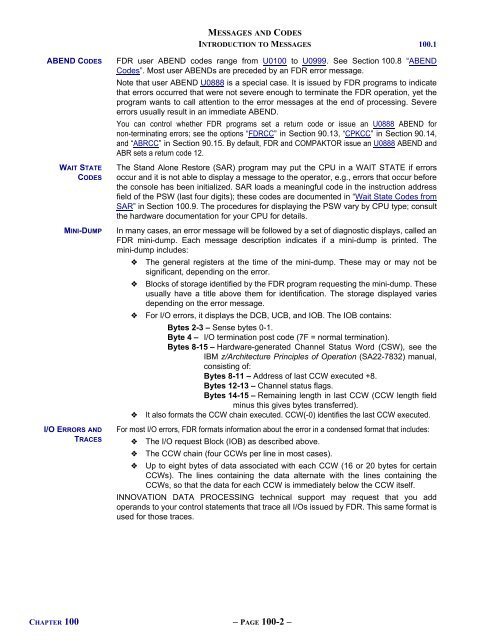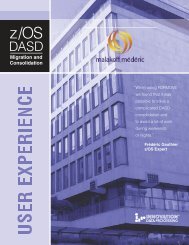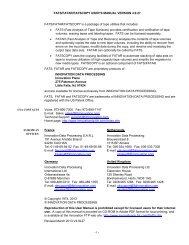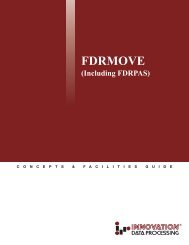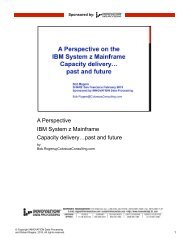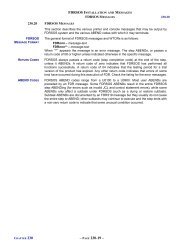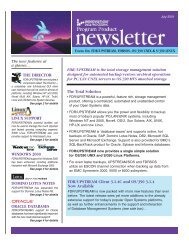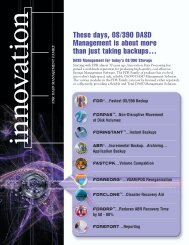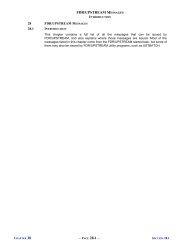FDR V54L78 - Innovation Data Processing
FDR V54L78 - Innovation Data Processing
FDR V54L78 - Innovation Data Processing
Create successful ePaper yourself
Turn your PDF publications into a flip-book with our unique Google optimized e-Paper software.
MESSAGES AND CODES<br />
INTRODUCTION TO MESSAGES 100.1<br />
ABEND CODES<br />
WAIT STATE<br />
CODES<br />
MINI-DUMP<br />
I/O ERRORS AND<br />
TRACES<br />
<strong>FDR</strong> user ABEND codes range from U0100 to U0999. See Section 100.8 “ABEND<br />
Codes”. Most user ABENDs are preceded by an <strong>FDR</strong> error message.<br />
Note that user ABEND U0888 is a special case. It is issued by <strong>FDR</strong> programs to indicate<br />
that errors occurred that were not severe enough to terminate the <strong>FDR</strong> operation, yet the<br />
program wants to call attention to the error messages at the end of processing. Severe<br />
errors usually result in an immediate ABEND.<br />
You can control whether <strong>FDR</strong> programs set a return code or issue an U0888 ABEND for<br />
non-terminating errors; see the options “<strong>FDR</strong>CC” in Section 90.13, “CPKCC” in Section 90.14,<br />
and “ABRCC” in Section 90.15. By default, <strong>FDR</strong> and COMPAKTOR issue an U0888 ABEND and<br />
ABR sets a return code 12.<br />
The Stand Alone Restore (SAR) program may put the CPU in a WAIT STATE if errors<br />
occur and it is not able to display a message to the operator, e.g., errors that occur before<br />
the console has been initialized. SAR loads a meaningful code in the instruction address<br />
field of the PSW (last four digits); these codes are documented in “Wait State Codes from<br />
SAR” in Section 100.9. The procedures for displaying the PSW vary by CPU type; consult<br />
the hardware documentation for your CPU for details.<br />
In many cases, an error message will be followed by a set of diagnostic displays, called an<br />
<strong>FDR</strong> mini-dump. Each message description indicates if a mini-dump is printed. The<br />
mini-dump includes:<br />
❖<br />
❖<br />
❖<br />
❖<br />
The general registers at the time of the mini-dump. These may or may not be<br />
significant, depending on the error.<br />
Blocks of storage identified by the <strong>FDR</strong> program requesting the mini-dump. These<br />
usually have a title above them for identification. The storage displayed varies<br />
depending on the error message.<br />
For I/O errors, it displays the DCB, UCB, and IOB. The IOB contains:<br />
Bytes 2-3 – Sense bytes 0-1.<br />
Byte 4 – I/O termination post code (7F = normal termination).<br />
Bytes 8-15 – Hardware-generated Channel Status Word (CSW), see the<br />
IBM z/Architecture Principles of Operation (SA22-7832) manual,<br />
consisting of:<br />
Bytes 8-11 – Address of last CCW executed +8.<br />
Bytes 12-13 – Channel status flags.<br />
Bytes 14-15 – Remaining length in last CCW (CCW length field<br />
minus this gives bytes transferred).<br />
It also formats the CCW chain executed. CCW(-0) identifies the last CCW executed.<br />
For most I/O errors, <strong>FDR</strong> formats information about the error in a condensed format that includes:<br />
❖<br />
❖<br />
❖<br />
The I/O request Block (IOB) as described above.<br />
The CCW chain (four CCWs per line in most cases).<br />
Up to eight bytes of data associated with each CCW (16 or 20 bytes for certain<br />
CCWs). The lines containing the data alternate with the lines containing the<br />
CCWs, so that the data for each CCW is immediately below the CCW itself.<br />
INNOVATION DATA PROCESSING technical support may request that you add<br />
operands to your control statements that trace all I/Os issued by <strong>FDR</strong>. This same format is<br />
used for those traces.<br />
CHAPTER 100 – PAGE 100-2 –


